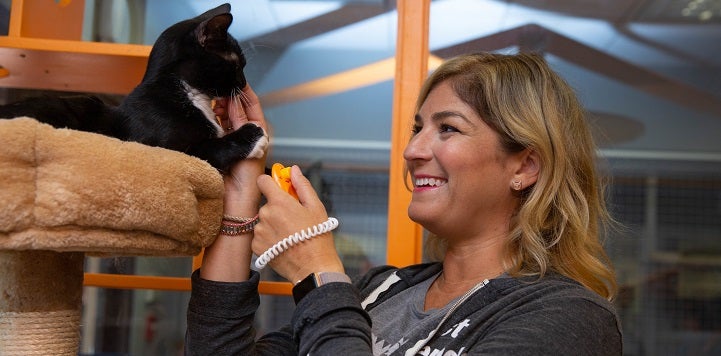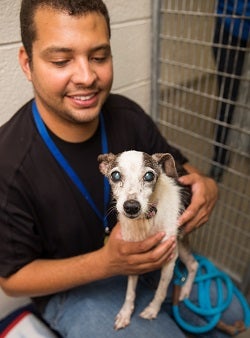
Getting Out of the Staffing Shortage Rut
Last week, we talked about how many shelters are struggling with sluggish adoptions and an uptick in intakes. Many of the things we would traditionally do to solve the space crunch are limited, however, because the field of animal sheltering, like many businesses right now, is also suffering from a staffing shortage. That means each staff person must shoulder a greater workload, diminishing the time available to spend with each animal or to explore lifesaving options. That leads to staff stress, which can lead to burnout and an exodus of staff from the industry. The result is a vicious cycle that is taxing shelters across the country.
We wanted to know more about the impact staffing shortages are having on shelter operations so, from July 28th to August 6th we surveyed shelters with government contracts, government animal services, private shelters without contracts and a mix of support groups, rescue groups and spay/neuter organizations. Out of 187 respondents, the survey found:
- Almost 87% say they are below normal staffing levels
- 62% are down by more than 10% of their normal staffing levels (22% are down by greater than 25%).
- 26% are down by less than 10% of their normal levels
- 71% say their reduced staffing levels are due to an inability to recruit, hire and maintain personnel, while only 14% cite budget cuts as the reason for being understaffed
- Only 30.5% of respondents say they are back to operating like they did pre-COVID
- 28.5% have shelter policies in place that restrict their hours
- 21% attribute their restricted hours to limited staff
- 13.7% have limited volunteer access
- 6.4% note limited hours/access due to local restrictions
And as for our original question regarding the impact of understaffing:
- 75% of respondents note that staff is even more stressed than usual
- 57% say they are providing lesser public service and adoption/foster support
- 42% say that they are unable to provide as much care/support for animals in the shelter
- 42% are unable to provide enough veterinary support
- 26% say they are unable to do major adoption events
While I’d love to be able to share an easy solution to the problem of attracting and keeping staff, unfortunately there isn’t one. But posting openings in all the usual places and expecting potential hires to find the listing and follow up on it no longer works like it once did. It’s time to analyze your strategies and expand into new territory.
Are You Using Active or Passive Recruiting Strategies? 
While you certainly should post job openings on all your typical channels, you can’t stop there. Today’s market demands more active recruitment strategies, like going on LinkedIn and searching in your field for potential leads. Indeed.com also allows you to search resumes that match your needs.
Make sure you are using social media to its fullest potential. In addition to posting on your organizational and/or municipal Facebook, Twitter and Instagram accounts, consider asking volunteers or staff to share out any opportunities that are available. Especially if your employees are happy with their jobs and are advocates for the organization, consider offering a referral incentive. There’s no reason why that incentive has to break the bank, either. Offer a $25 gift card or a free day of time off to anyone who refers your next successful hire.
Virtual job fairs also may turn up potential candidates. Particularly if your vacancies are in non-animal care areas, college job fairs can be good places to let people know that all kinds of skillsets are needed in animal shelters.
Make any of your postings as visually interesting as possible. Use photos, or—better yet—consider putting together a recruitment video that shows what it’s like to work at your shelter. Nothing motivates people to apply for a job like seeing what a great place it is to work.
If you have not made a concerted effort to reach diverse communities, it’s time to start. We flock to people who are like us, which limits the job pool and does little to expand foster, volunteer and adopter candidates beyond those we already reach. You can tap into a diverse group of candidates by posting your jobs (don’t forget those photos or recruitment video) on such websites as Women's Career Channel, iHispano, BlackCareerNetwork, AsianCareerNetwork, OutProfessionalNetwork, ProAble, as well as the job listing pages maintained by the National Association of Colored People, National Urban League, Military2Career and Veterans Exchange.
Can You Inspire Every Staff Person to be an Advocate?
It would be great if every shelter could have a community liaison consciously building a strong, positive reputation about your organization. That person can spend all their time finding ways to keep the name of your organization front and center in everyone’s mind and share the amazing work you are doing in a way that engenders public admiration and support. Even if you’re lucky enough to have such an employee, being a community liaison should be part of the job for every member of your staff.
Mia Navedo-Williams, Best Friends’ senior specialist in multicultural marketing, calls this the “good neighbor strategy.” It involves every member of your staff connecting with everyone they meet and talking positively about the organization and their experience working there. Contented staff members won’t hesitate to advertise job opportunities to their network, and there is likely to be at least one individual in their network who wants to come join an organization that inspires such allegiance in its staff.
Finally, Is Your Shelter a Place Where People Want to Work?
 If you have low turnover and employees who don’t hesitate to tell friends, family and even strangers how much they enjoy their workplace, you have a powerful tool to find people to fill vacancies. If, however, your work environment is not exactly something to write home about and you can’t keep staff, it’s time to figure out why.
If you have low turnover and employees who don’t hesitate to tell friends, family and even strangers how much they enjoy their workplace, you have a powerful tool to find people to fill vacancies. If, however, your work environment is not exactly something to write home about and you can’t keep staff, it’s time to figure out why.
Granted, there will always be a fair rate of turnover in an industry as emotionally and physically taxing as animal sheltering (and one marked by notoriously low wages). But frustration and burn out—and bailing out for good—also occur when staff don’t feel supported or appreciated.
Shelter leaders should be talking to their staffs and finding out what could help make them happier in their jobs. It’s important to look at your workplace through the lens of psychological safety. Simply put, that means that staff feel safe to speak up, share what’s going on (including when things are not going well) and communicate without fear of retribution or being devalued.
Create such an environment by clearly communicating with your teams, and that involves active listening. Be curious about what your staff has to say; ask them questions that show them they are being heard, and that help you find ways to value them and keep them engaged. Find one thing every day that your employee does well and show your appreciation for that specific contribution.
Every employee must do tasks that aren’t their cup of tea. However, if they are never given opportunities to use their strengths, they are likely to do poorly overall, disengage or go elsewhere. Making sure they are aligned to what they do well will motivate them, so they are happier and more engaged. It also helps put a stop to the vicious cycle of always recruiting, interviewing, hiring and training new staff who are destined to feel stressed and overworked.
It can be difficult to expand beyond your comfort zone, especially in a time where everyone is hustling just to get the day-to-day work done. Until our industry stretches and puts significant energy into building and retaining engaged employees, however, we will continue battling the cycle of staffing shortages and its crushing impact on the people and animals we serve. While we know the animals in our care depend on us, we can’t neglect tending to the people whose job it is to care for them.
Brent Toellner
Senior director, national programs
Best Friends Animal Society
If you enjoyed this editorial, you can find our complete catalog of editorials here.